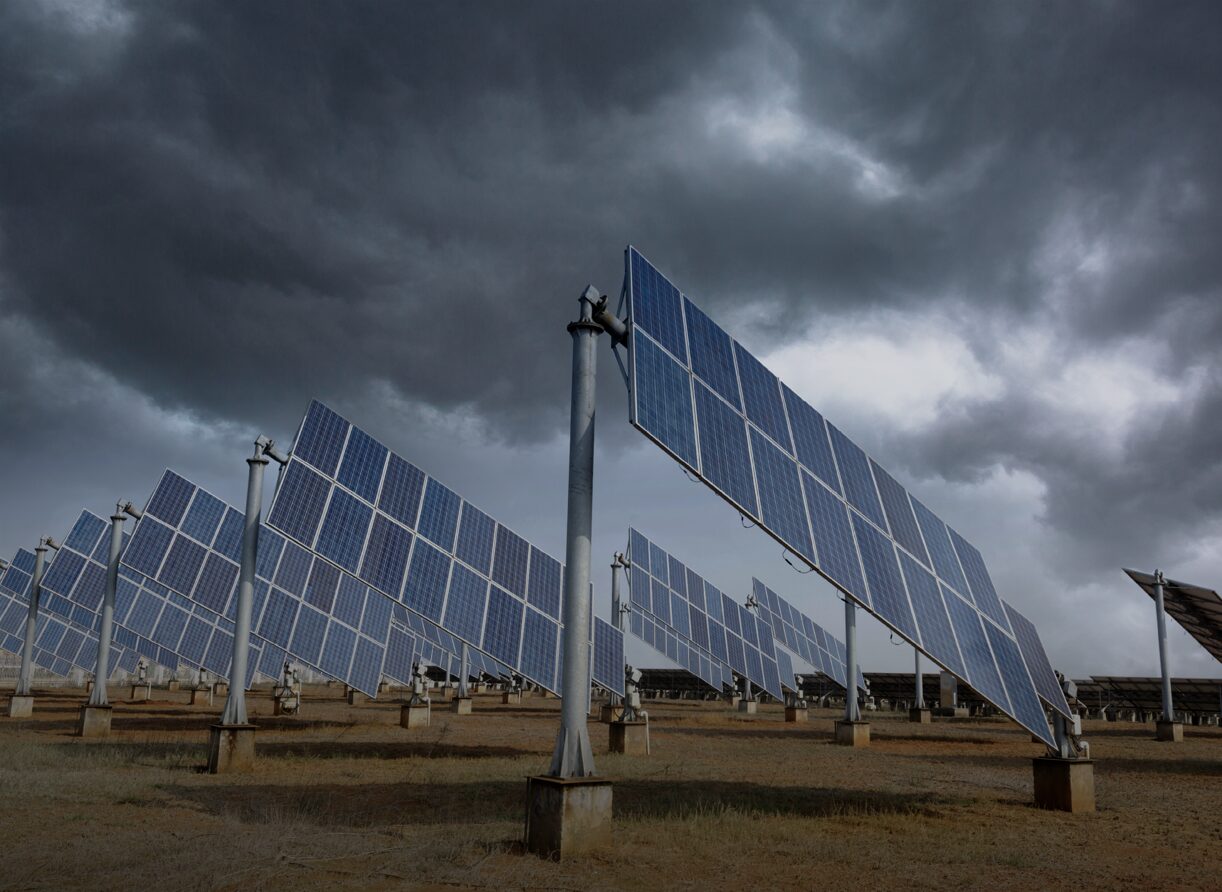Solar operators should stow for hail, not wind.
June 18, 2025

The following article was originally published by Solar Power World https://www.solarpowerworldonline.com/2025/06/flip-your-thinking-solar-operators-should-stow-for-hail-not-wind/
As hail season intensifies and insurance premiums spike, utility-scale solar operators are exploring new approaches to asset protection, including “stowing smarter” by tracking wind direction. The concept has merit: predict wind patterns, position panels accordingly and protect valuable infrastructure from storm damage. However there’s a critical meteorological reality that deserves attention. In severe convective storms, wind direction becomes chaotic, turbulent and fundamentally unpredictable.
The meteorological reality
Large hailstorms and severe thunderstorms generate their own wind fields. Powerful downdraughts from cooling precipitation slam into the ground, spreading out in all directions and creating gust fronts or outflow boundaries that often contradict regional, synoptic-scale forecasts.
The wind near a thunderstorm is not necessarily the normal gradient wind — a result of air pressure gradient, the Coriolis force, other accelerations and friction. It can shift faster than any reaction time allows. Data from Doppler and reflectivity radar also have significant limitations in observing, let alone predicting, local surface winds in the vicinity of these storms. Greater transparency about these limitations would benefit the entire industry.
This distinction matters significantly. It’s the difference between informed decision-making and reactive guesswork when protecting critical assets.
The real threat matrix: hail vs. wind
Wind during severe hailstorms represent a legitimate concern. Solar operators rightfully seek solutions for wind damage, which can dislodge panels and damage mounting systems, though serious structural damage typically requires sustained speeds exceeding 100 mph. The scale of threat, however, differs dramatically when comparing wind and hail damage.
While wind damage represents a significant annual cost to the industry, recent analysis from the 2025 Solar Risk Assessment reveals that hail damage dominates the threat landscape. Hail accounts for 73% of all solar claims costs by damage amount, with individual events causing $50-80 million in losses. The Midway Solar Project exemplifies this disparity. A 2019 storm system resulted in $70-80 million in losses and damage to around 400,000 panels overwhelmingly from hail impact, although significant winds also occurred. This weather threat is expanding beyond traditional “hail alley” regions, with kWh Analytics finding 19% of recent hail losses occurring in North Carolina, an area not historically considered high-risk. Understanding these evolving patterns becomes critical when considering protection strategies.
The meteorological reality remains challenging. Predicting localized wind behavior near storm outflows is extraordinarily difficult, yet wind direction tracking continues to be pursued as a solution. Greater transparency about these forecasting limitations could help solar operators direct their asset protection resources toward technologies and strategies that deliver proven results. Consider the stark financial reality:
Hail damage now represents the single largest weather-related threat to utility-scale solar.
- Responsible for 73% of all solar claim’s costs by damage amount
- Average hail claim: $58.4 million
- 2022 losses: $300-400 million from hail damage alone
- 27% of PV plants have a 10% annual chance of seeing 2-inch or larger hail in their vicinity
- Recent examples include the Fighting Jays Solar Farm, where golf ball-sized hail damaged thousands of panels at the 350-MW facility in 2024.
- source: 2025 Solar Risk Assessment, kWh Analytics
Wind damage, though a genuine concern, operates at a different scale.
- Requires sustained speeds above 90 mph for serious structural damage
- Storm-related incidents account for 10.9% of total solar risks
- Average costs per incident: $207,417 to $1.2 million
- source: Clir Renewables
The vulnerability gap is telling. Solar panels are more susceptible to hail impact than wind force. Large hailstones can shatter panels instantly, while smaller hail creates “invisible” microcracks that compromise long-term performance. Wind damage typically requires significantly higher speeds and sustained exposure, making hail the more immediate and frequent threat to solar assets.
Focusing on science-based solutions
KISTERS has its own approach around responding to verified conditions rather than assumed wind behavior. The HailSens360 solution provides comprehensive storm intelligence, from forecasting through real-time sensing and analysis. The system begins with advanced forecasting capabilities; the proprietary Nowcast blends optical flow models to optimize radar-based storm motion vectors, delivering 90-minute advance warnings with hyperlocal precision. During events, on-site sensors measure hail impact in real time. Following storms, detailed post-event analysis quantifies the full scope of conditions, informing damage assessment and supporting insurance claims. This holistic approach enables solar operators to make confident decisions based on verified hail intelligence across the entire storm lifecycle.
Moving forward with meteorological reality
Wind-based approaches reflect the industry’s genuine desire to protect assets through any available means. However, data suggest focus is better directed toward verified hail detection, accurate short-term prediction and technologies built on proven meteorological principles.
The evidence is clear in insurance data and financial losses. The industry’s strategic focus deserves alignment with meteorological reality. Hail represents the primary quantifiable threat, as wind prediction near severe storms remains challenging. Solar operators benefit most from solutions grounded in verified science.
Understanding these distinctions drives more effective asset protection. Guidance for operators is clear: When in doubt, stow for hail, not wind.
Johan Jaques serves as Chief Meteorologist with The KISTERS Group, an innovative global leader in environmental data management solutions trusted by governments and utilities worldwide. Bringing over 35 years of meteorological expertise to severe weather forecasting and solar asset protection, Johan holds an MSc in meteorology from KU Leuven and is a member of the Royal Meteorological Society (UK). At KISTERS, Johan serves as Solution Owner for HailSens360, the company’s comprehensive hail intelligence platform that combines advanced forecasting with real-time sensing technology. His extensive experience in severe convective storm prediction and renewable energy applications provides unique insight into the meteorological challenges facing U.S. solar operators in hail-prone regions.